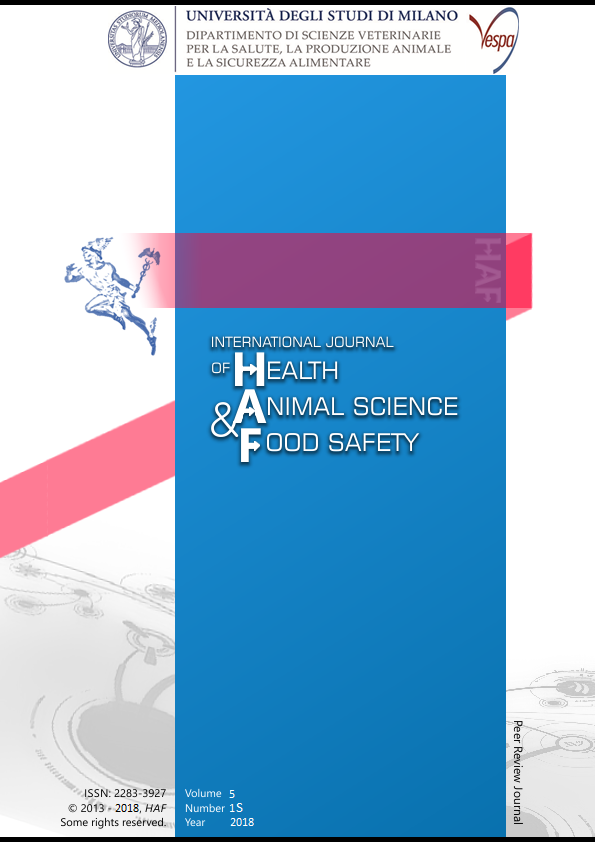Abstract
Organochlorine pesticides (OCPs) and polychlorinated biphenyls (PCBs) are synthetic chlorinated compounds classified as POPs whereas only the penta e tetra-brominated polybromodiphenyl ethers (PBDEs) are so defined by the Stockolm Convention (Stockholm Convention, 2005) in order to elimitate or restrict the use of POPs. Organophosphorus insecticides (OCPs) represent important environmental and food contamination sources, widely used in agriculture. Among polyciclic aromatic hydrocarbons (PAHs), benzo[a]pirene is classified by IARC in Group 1, as cancerogen and Benzo[a]fluoranthene as a Group 2B, as possible cancerogen (IARC, 2012; IARC, 2010). EFSA (European Food Safety Authority) has released a scientific opinion on the risks to public health related to the presence of brominated flame retardants in food (EFSA, 2011) and in 2014 European commission has asked Member States to monitor the presence of brominated flame retardants (BFRs) in food over the next two years (EC, 2014). Due to their heir n-octanol/water partition coefficient (log Kow), they accumulate in fat tissue, bioconcentrate and biomagnify in the animals at the higher trophic levels, possibly causing, through chronic exposure, endocrine disruption and cancer (Wania et al., 1995; Vallack et al., 1998). The aim of this study is to evaluate the presence of OCPs, PCBs, PBDEs and PAHs in chamois and wild boar from Eastern Piedmont, Italy. A total of 20 chamois and 20 wild boar muscle samples were collected during the hunting season 2017, from Verbania Cusio Ossola (VCO) (Fig 1). The chemical analysis for the detection of OCPs, PCBs, PBDEs, and PAHs was performed by GC-MS/MS on muscle samples purified and extracted using a QuEChERS technique, validated according to SANTE 2017 (SANTE/11183/2017). These preliminary results show the ubiquitary presence of the studied contaminants. PCBs have been found more in chamois (45%) than in wild boar (35%). No PBDEs were detected in wild boar but in chamois were found with a prevalence of 35% and concentration 0.25-1.52 ng g-1. About OCPs, phorate and demeton were found in wild boar (55%-15%) and chamois (32%- 35%) with range concentrations 0.21-20.1 ng g-1. No PAHs were detected, expect antharacene for one samples in wild boar (0.53 ng g-1). Further studies are in progress in order to correlate environmental contamination and game animals.
Riferimenti bibliografici
Commission Recommendation (EC), 2014. On the monitoring of traces of brominated flame retardants in food. Official Journal of the European Union. L 65/39.
Directorate-General for Health and Food Safety (DG_SANTE), 2017. SANTE/11813/2017. Guidance document on anylitical quality control and method validation procedures for pesticide residues and analysis in food and feed.
EFSA Journal. 9(5), 2156. Scientific Opinion on Polybrominated Diphenyl Ethers (PBDEs) in Food. EFSA Journal 9.
International Agency for Research on Cancer (IARC), 2010. IARC monographs on the evaluation on carcinogenic risks to humans.Benzo[a]fluoranthene. 92, Sup 7.
International Agency for Research on Cancer (IARC), 2012. IARC monographs on the evaluation on carcinogenic risks to humans. Benzo[a]pyrene. Sup 7, 92, 100F.
Stockholm Convention on Persistent Organic Pollutants. United Nations Environmental Progamme. http://chm.pops.int/TheConvention (accessed 24.04.18).
Vallack, H.W., Bakker, D.J., Brandt, I., Broström-Lundén, E., Brouwer, A., Bull, K. R., Koch, R., 1998. Controlling persistent organic pollutants–what next?. Environmental Toxicology and Pharmacology. 6, 143-175.
Wania, F., Mackay, D., 1995. A global distribution model for persistent organic chemicals. Science of the Total Environment.12, 211-232.
This work is licensed under a CC BY-SA 4.0 international

